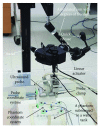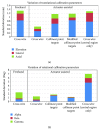Actuator-Assisted Calibration of Freehand 3D Ultrasound System
- PMID: 29854371
- PMCID: PMC5954878
- DOI: 10.1155/2018/9314626
Actuator-Assisted Calibration of Freehand 3D Ultrasound System
Abstract
Freehand three-dimensional (3D) ultrasound has been used independently of other technologies to analyze complex geometries or registered with other imaging modalities to aid surgical and radiotherapy planning. A fundamental requirement for all freehand 3D ultrasound systems is probe calibration. The purpose of this study was to develop an actuator-assisted approach to facilitate freehand 3D ultrasound calibration using point-based phantoms. We modified the mathematical formulation of the calibration problem to eliminate the need of imaging the point targets at different viewing angles and developed an actuator-assisted approach/setup to facilitate quick and consistent collection of point targets spanning the entire image field of view. The actuator-assisted approach was applied to a commonly used cross wire phantom as well as two custom-made point-based phantoms (original and modified), each containing 7 collinear point targets, and compared the results with the traditional freehand cross wire phantom calibration in terms of calibration reproducibility, point reconstruction precision, point reconstruction accuracy, distance reconstruction accuracy, and data acquisition time. Results demonstrated that the actuator-assisted single cross wire phantom calibration significantly improved the calibration reproducibility and offered similar point reconstruction precision, point reconstruction accuracy, distance reconstruction accuracy, and data acquisition time with respect to the freehand cross wire phantom calibration. On the other hand, the actuator-assisted modified "collinear point target" phantom calibration offered similar precision and accuracy when compared to the freehand cross wire phantom calibration, but it reduced the data acquisition time by 57%. It appears that both actuator-assisted cross wire phantom and modified collinear point target phantom calibration approaches are viable options for freehand 3D ultrasound calibration.
Figures





References
Publication types
MeSH terms
LinkOut - more resources
Full Text Sources
Other Literature Sources

